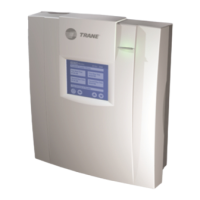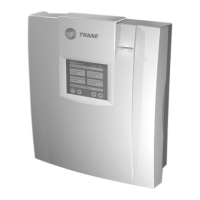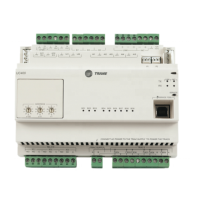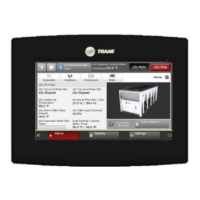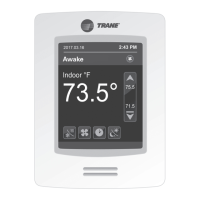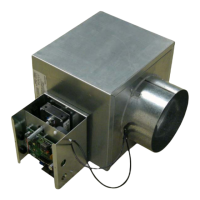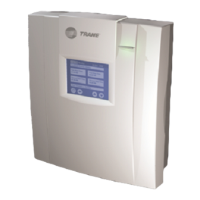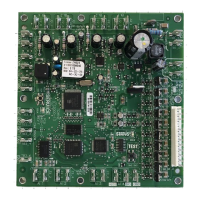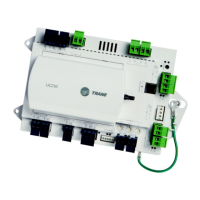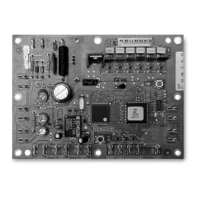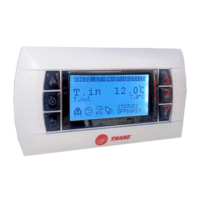Table 25. Binary outputs 1 and 2 troubleshooting of configuration and operation for 2-stage
Step Number Action Probable Cause
Step 1
Connect the Rover service tool to the LonTalk communication link, start th
e Rover service tool,
and select the MP501 you are troubleshooting from the Active Group Tree. The device plug-in
for the selected MP501 will appear with the Status screen displayed in the workspace.
See the Rove
r Service S
oftware Installation, Operation, and Programming Guide (EMTX-
SVX01).
—
Step 2
Select the Configuration button to display the Device Co
nfiguration screen. Select the PID tab
and verify the maximum output.
If the PID maximum is less than 30%, binary output 1 will not com
e on. If the PID maximum
is less than 70%, binary output 2 will not come on. See Figure 8, p. 22.
Verify that the gains are not 0. If all three gains are 0, the PID output will always be 0 and both
outputs will be off.
PID loop
configuration
pr
oblem.
Ste
p 3
Select the Close button to display the Status workspace,
then look on the Unit tab.
Is the MP501 in unoccupied mode if configured as SCC? If conf
igured as generic the MP501 may
be disabled. If the mode is unoccupied (SCC) or disabled (generic), the controller commands
both outputs off.
If the controller is unoccupied but you think it should be in a diffe
rent state, see “Occupancy
Arbitration (Only SCC Mode),” p. 52.
The MP501 is in
unoccupied
mode
(SCC) or disabled
mode (generic).
Step 4
At the Unit tab in the Status workspace, check diagnostics.
In SCC mode, if you’re not using the network space temperature input and the hardwired space
temperatur
e input fails, binary outputs 1 and 2 go off.
Similarly, in generic mode, if you’re not using the network input and th
e hardwired input
(temperature, flow, pressure, percent, ppm) fails, binary outputs 1 and 2 go off. The controller
will return to normal operation when the sensor is no longer failed.
Sensor failure
diagnostic.
Ste
p 5
Compare the input to the setpoint.
In SCC mode, the controller may be calculating
that no heating or cooling capacity is required
at this time, so it is normal for binary outputs 1 and 2 to be off.
Similarly, in generic mode, the input may be close enough to the setpoint that binary outputs
1 and 2 remain off.
C
apacity not required.
Step 6
Check to see if either of the network variables nviCmdOverrid
e or nviEmergOverride is keeping
binary outputs 1 and 2 off. These variables can override the output.
To view nviCmdOverride and nviEmergOverride, refer to the Rover Service So
ftware
Installation, Operation, and Programming Guide (EMTX-SVX01).
Override.
52 CNT-SVX08F-EN
Troubleshooting
Occupancy Arbitration (Only SCC Mode)
This section describes in detail how the MP501 determines its occupancy mode. Use Table 27, p. 54
and Table 28, p. 55 to verify why the MP501 is in its current mode.
The occupancy of the controller in SCC mode is determined by evaluating the combination of three
co
mmunicati
ng inputs, the hardwired occupancy input, and the timed override on and cancel
buttons on the Trane zone sensor.
Three different communicating inputs affect the controller's occupancy mode:
• Occupancy—manual com
mand (nv
iOccManCmd)
• Occupancy—schedule (nviOccSchedule)
• Occupancy—sensor (nviOccSensor)
These outputs provide maximum flexib
ility, but the number of inputs used varies with the
application.
Occupancy; Manual Command
Some communicating devices may request occupancy based on the information communicated
in the network variable known as nvoOccManCmd. Trane systems and zone sensors do not
communicate this information to the controller, but the controller accepts this network variable as
a communicated input nviOccManCmd.
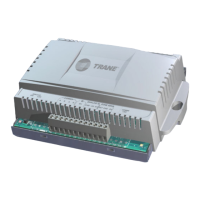
